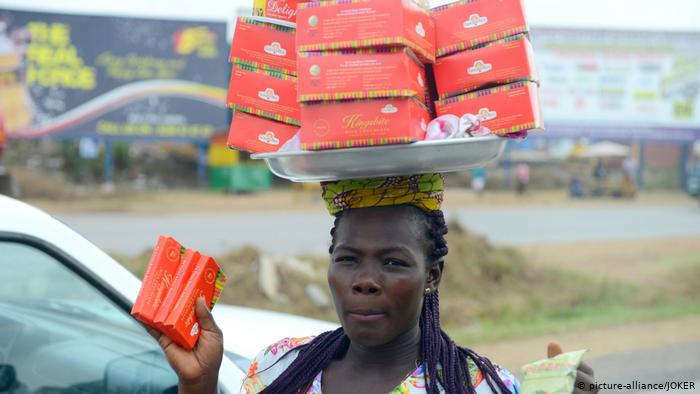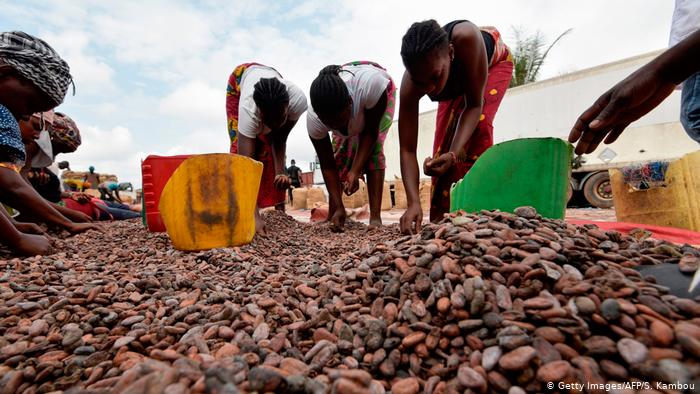[ad_1]
Ghana has announced an increase in the guaranteed price of cocoa it pays to farmers by 28% per tonne for the new growing season. It is the latest attempt by the West African nation to improve the livelihoods of its farmers.
Ghana is the world’s second largest cocoa exporter, after Ivory Coast, and exports around 850,000 metric tons of cocoa each year. Most of it is unprocessed, ready to be made into chocolate and other products in Europe and the United States. But in recent years, production has fallen by around 30%.
The aging of cocoa trees, poorly managed plantations and drought have contributed to the decline of the sector. If production in Ghana continues to decline, it will have consequences not only domestically, but also for manufacturers internationally.
Farmers benefit
However, the latest increase in the price of cocoa means that farmers can afford to plant new cocoa and also employ skilled workers, rather than child labor.
“The increase in the price of cocoa beans will boost the morale of the farmers and we congratulate Ghana’s leadership for this initiative,” Moses Djan Asiedu of the World Organization of Cocoa Producers told DW.

Low income among cocoa farmers is a big concern because in Ghana, they depend on cocoa for 90% of their income. And due to unpredictable calamities, like weather patterns, they sometimes get poor harvests.
Sampson Adu Essel and his wife are cocoa farmers in eastern Ghana, and will harvest their cocoa in the coming weeks. They attribute the delay in harvest to climate change.
“You can weed your cocoa, prune, apply your fertilizer and the weather is not good for you,” Essel said. “Then all the cocoa will turn red prematurely. That is the biggest challenge. “
But the good news is that your cocoa will be priced higher compared to last season.
“I’m going to make a lot of money this year because I have about five farms that are on 21 acres,” Essel told DW. “So if I harvest about ten bags from an acre, you can imagine how much I’m going to earn.”

A lucrative industry with poor pay
The cocoa and chocolate industry is worth $ 131 billion, according to marketandmarkets.com, yet when that number is broken down, smallholder cocoa farmers receive 6% of the industry’s ever-growing annual value. . The rest goes to cocoa processors, chocolate manufacturers and their marketers, all predominantly in the West.
Asiedu believes that such income disparities must end. “The 6% cannot be something farmers should be happy with, he said. “Because we are talking about sustainability where farmers involved in production are getting old.”
“Today’s youth are not at all attracted to cultivating cocoa. We have children who show no interest because they have seen what happened to their parents. “
Market forces against cocoa prices
For many years, cocoa prices have been subject to global market prices, Edward Akapire of the Fairtrade Africa West Africa Network told DW. Therefore, an increase in the guaranteed minimum price for cocoa producers is an attempt to correct some of these imbalances.
“The Ghanaian government initiative is to bridge the gap between what farmers currently earn and what they are supposed to earn in order to ensure a decent livelihood for their households,” added Akapire.
There have been complaints from condescending Fairtrade cocoa producers for the benefit of all but the cocoa producer. However, Akapire refuted these allegations, telling DW that “cocoa farmers in Ghana who are Fair Trade certified received a spread for their cocoa sales under fair trade terms that did not accrue to other non-certified producers “.
Ghana is one of the main suppliers of cocoa to the EU market, to which it has duty-free and quota-free access under their respective EPAs.
With the new minimum cocoa prices, farmers like Adu Essel hope to improve their livelihoods and boost production in the coming years.